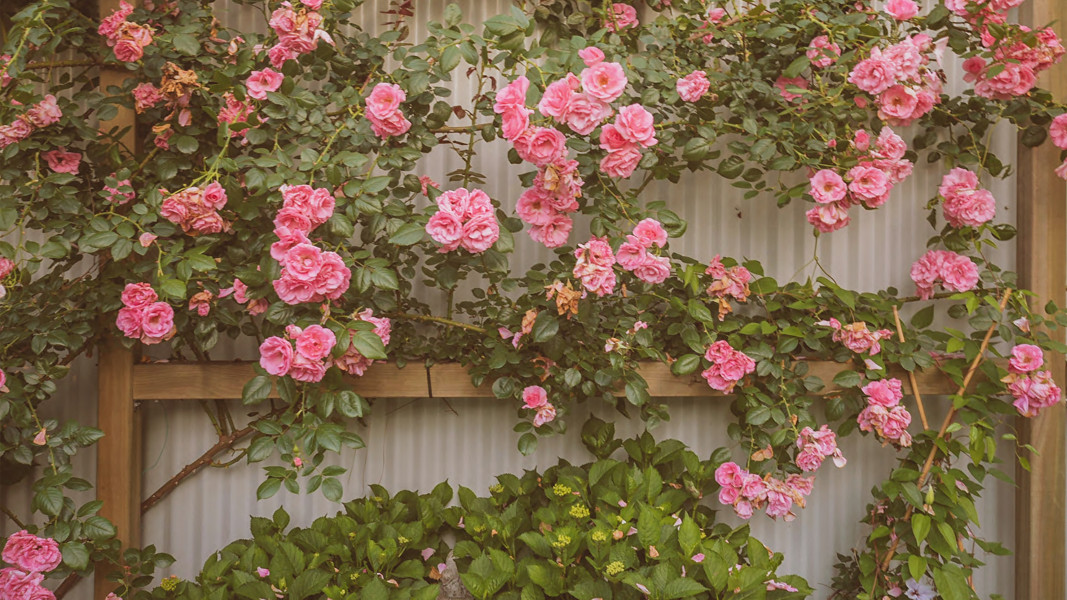History of English Roses
In the 1960s, the golden years of the tea-hybrid rose, the young English gardener David Austin was inspired by a book on old varieties of roses. At the time, they were considered old-fashioned, with many shortcomings - such as a short flowering period, taking up a lot of space, limited range of colors and highly susceptible to disease. Few people have noticed their advantages - the magnificent flowering, the strong aroma, the natural bushy habit, the fruits that appear on most of them in autumn. This young gardener decided to create a hybrid that combines the best characteristics of old roses with the best characteristics of modern varieties. His idea was not well received by the then producers and traders, who believed that the future lay in the creation of new colors of tea-hybrid roses. Convinced that the development of the rose had gone in the wrong direction, he began his selection work. By 1969, several successful hybrids had been created, and he decided he had something new to present to the world, calling the newly formed group English Roses.
The great success came in 1983, when at the world-famous garden exhibition in Chelsea presented the roses Graham Thomas and Mary Rose. From that moment on, English roses quickly gained popularity both in Britain and around the world. To date, David Austin has presented more than 200 species of roses, many of which have won awards, and the Graham Thomas rose has won the World's Favorite Rose Award at the World Federation of 41 National Rosary Societies.
Main characteristics of English roses
English roses combine the delicate charm and aroma of old roses (Damascene rose, French roses, Alba rose, etc.) with a wide range of colors and long flowering of modern roses (tea-hybrid, floribunda, etc.). Tested in different climates around the world, they have been shown to be among the most hardy and disease-resistant roses.
English roses have a shape very similar to that of old roses, which can range from simple (up to 8 petals) to very showy (over 40), and in some species the number of petals exceeds 100. Most of the representatives are cup-shaped (Claire Austin, The Alnwick Rose, Geoff Hamilton) or with a rosette / pompom (James Galway, Crocus Rose, Grace). An attractive variety are the varieties with color divided into 4 distinct parts.
The rich variety of charming aromas is another characteristic feature that is inherited from the old varieties. Among them can be found the beautiful aroma of Damascene rose, that of Tea Rose, Musk Rose, Myrrh, as well as many different fruit aromas. Among the favorites of gardeners because of its wonderful fragrance are the varieties Gertrude Jekyll, The Alnwick Rose, Graham Thomas, Abraham Darby, A Shropshire Lad, Harlow Carr, Claire Austin, Teasing Georgia, Eglantine, Pat Austin.
English roses have a natural bushy growth and are well leafy, which makes them a favorite plant for the garden. The size of the bushes is different - there are varieties that reach quite impressive sizes - 47 - 59 in and others that are no larger than 31 - 35 in. There are few that are upright, but they are suitable for the background.
Caring for English roses
In order to enjoy healthy plants, and to give the best of themselves, it is necessary to water and fertilize regularly according to the season, and to comply with the requirements valid for other types of roses.
In countries where the summers are very hot, which requires watering early in the morning, while the soil is relatively cool. In order for the bushes to bloom more abundantly, they also need to periodically remove the overblown flowers, and this is done in two ways - either by removing only the button or by cutting to the first outer leaf. Pruning is done in the second year (at least 12 months after planting) in early spring, immediately after weeding, before the buds develop. Medium pruning is used, removing about half the length of the stems.
The use of English roses in the garden
English roses are widely used in the garden, given their natural bushy growth, diverse shape and color of flowers and leaves. They are remarkably adaptable plants and grow well both alone and in the company of other shrubs and grasses.
Flower beds
A well-maintained classic rose bed would grab everyone's attention. Among English roses there are many representatives with smaller sizes - less than 35 in, which can be successfully used for this type of arrangement. And when we add the right flavor, the effect is stunning.
Mixed shrub borders
Most people are not used to seeing roses in the company of other shrubs or grasses. According to many authors, the queen of flowers does not tolerate competition and it is best to grow separately.
This is not a problem for English roses. The very idea of their creation was to get as close as possible to naturally growing species. Their graceful and vibrant bushy growth makes them ideal for mixed curbs.
This allows gardeners to combine their favorite plants and shrubs, to create a wonderful palette of color, shape, appearance and aroma.
Thanks to the variety of English roses, especially the cup-shaped and rosettes, it creates a great contrast with more delicate plants. The effect of the mixed border will be strongest if it is surrounded by low plants to act as a frame. However, avoid very aggressive shrubs and grasses that can suffocate roses. Use the tall roses in the background, the lower ones in the foreground, and in order to get a truly harmonious look, plant the roses in compact groups - for example three, and between the different groups plant the contrasting plants. Suitable companies are lupine, large-flowering geranium species, lavender, salvia, delphinium, rosemary and a number of other herbaceous and shrub species.
Hedge
There is nothing better than a hedge that delights us with colors and aroma from late spring to late autumn. English roses, with their vital growth, are leaders in this regard, creating a dense natural barrier, moreover, the presence of thorns protects against unwanted visitors. An important requirement for obtaining a good hedge is to follow the following rule - when planting lower species to leave 20 in distance between individual plants, and in higher species up to 40 in. The desired height is achieved by pruning, and you can easily use a brushcutter for easier maintenance.
Flower bouquet of English roses
Probably no one can remain indifferent to the magical sight of a
bouquet of English roses. Their romantic spirit is captivating. Almost all of the species can be used for cut flowers, and their harmonious relationship with herbaceous and most shrubby plants gives unlimited possibilities to the imagination. However, as flower arrangements of English roses are quite difficult to find, you can always send the classic
bouquet of roses to a loved one for a special occasion.

